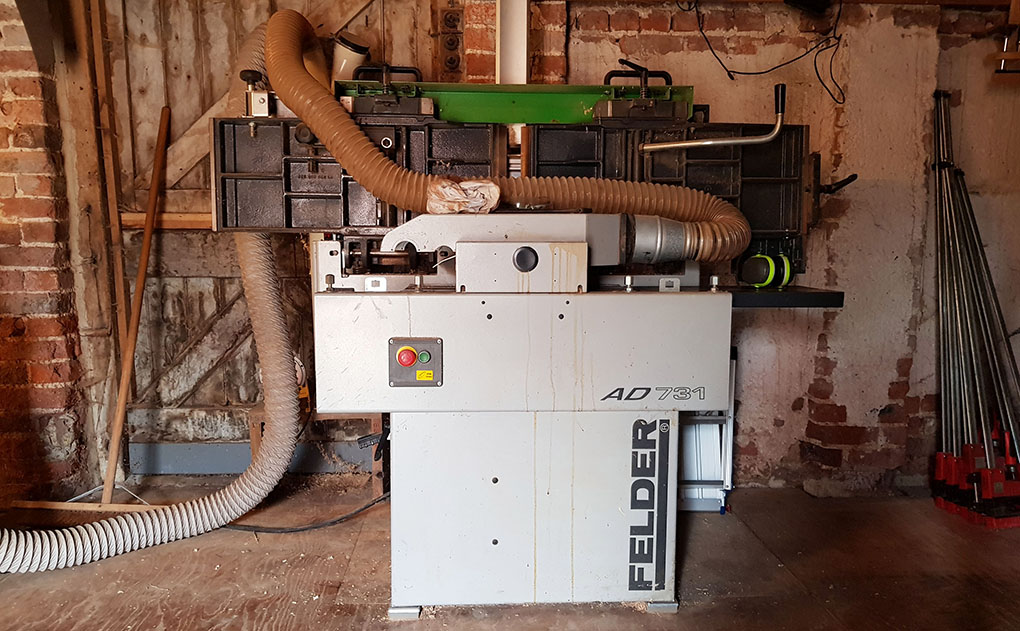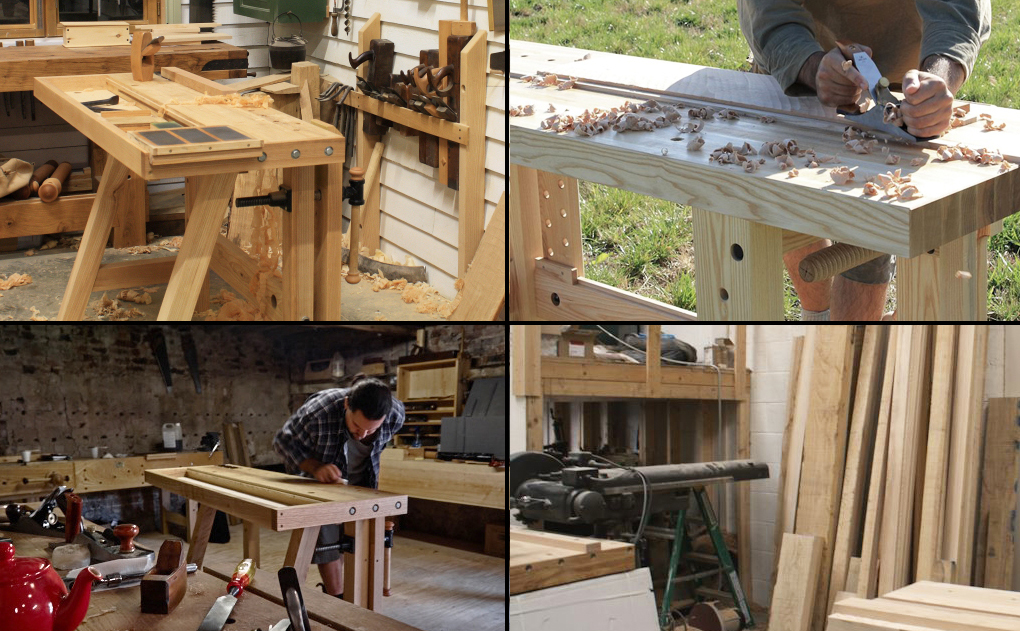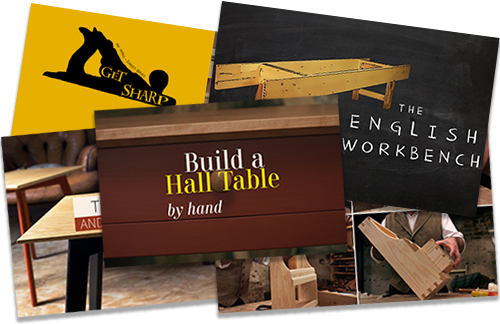It seems to be normal practice to sit a workbench against a wall and this is something I’ve often done myself. But having worked in many different layouts I now tend to favour bringing the workbench right out away from the wall instead. In a small workshop this can feel like a huge waste of space but if you’re like me and treat your workbench as the heart of your workshop then it makes sense to give it all the space it deserves.
I’ve touched on this a bit before in an article about tool storage. At that time I was doing all of my hand work in a corner of the main workshop and wanted to point out the convenience of being able to stand between your bench and your tools. This works especially well if you have everything hung or on shelves across the wall as you can quickly turn around, grab a tool then carry on working.
The obvious downside of sitting a bench against a wall comes when your planing across the grain as you could end up with your plane being shooved right in to it. I don’t often plane cross grain so that’s not too much of an issue, but I still find myself with work overhanging the bench so having a wall in the way would be a problem. It’s also more awkward to grab tools off the wall if you’re having to stretch to reach over the bench. Another thing I’ve noticed with having a big wall dead in front of me is somehow it makes me feel that the back half of the bench is written off – but maybe that one’s just me? Although I certainly can’t imagine many people would enjoy staring at wall all day!
I had always considered my prefered bench position to be more costly in terms of space though, especially in a small workshop. When I moved my hand tools over in to the ‘filming’ room this became more apparent because I could only fit in a 5′ workbench. If it went against the wall then I could have easily gone to 6′ or more.
A recent post on the She Works Wood blog (thanks for the mention!) made me think about this a little differently. In her post Marilyn wrote about the bench positioning that I use and how mimicking this actually made better use of the space in her small workshop. This was a great point to see and shows that bringing the workbench out can actually be space gaining in a small hand tool focused area. It gives you a nice working area with quick access to the tools and a clear assembly spot in front of the bench. It’s certainly been working out well in my little hand tool hovel and I’m pleased to hear it’s worked out here as well.
So the question isn’t as simple as ‘Where have you positioned your workbench?’ but also ‘Why?’ and have you really ever given it any thought?


![Simple Work Holding For Ploughing Grooves [Without a Tail Vice]](https://www.theenglishwoodworker.com/wp-content/uploads/2022/07/workholding-without-tail-vice-copy.jpg)



I too have come to the same conclusion over the past year. I used to work in a 1 car garage with my bench against the wall and always wanted more space, then I moved indoors to a spare bedroom. Making the switch was at first difficult, but also a pleasure. I was happy to finally have A/C, heat, and a window. I worked with my bench against the wall for a while, then realized it just wasn’t going to work. I was pulling my bench away from the wall all the time and it just didn’t make any sense to me anymore. I finally pulled it about 3 feet away from my tool wall and now work between it and my bench, like your shop really. This has been great for work fluidity and I still have room to cut stock on my sawbenches. My current bench is 8 feet long and the shop is only 10×14. Might seem small, but I really do have all the room I need for hand tool work.
Hi Bill, it sounds like your workshop is pretty much the same size as my hand tool room and we’ve also come to a very similar conclusion for the layout. I find this plenty space for hand tool use, I don’t know about you but I can find it restrictive for the camera angles though. What with your A/C, heating and window…all you need now is a nice pot of Darvilles and your life’s made!
My current bench is positioned against (or rather attached to) a wall. Why? aside from the obvious, I haven’t built my primarily joinery bench yet. I have been leaning toward this “away from the wall” position in my shop as I’m upgrading my garage shop (insulation, heating and sheeting) has caused me to rethink my layout. (since I pulled everything off the walls) the natural wall (away from the cars, has some plumbing, crawlspace and other issues that prevent me from pushing up against, plus I think as I’m moving to enclosed storage, think it is more suitable. I don’t do a lot of stock prep at this bench, so it probably won’t need the added restraint a wall offers.
Hi Richard,
My bench is away from the wall so I can work across its width when needed. The wall behind me is where I will have my planes, saws, and my most used tool so I just have to turn around and, either put one back, or get the next.
I have tried it next to the wall, man I felt so closed in and restricted, HaHa I was not happy trying to work with a wall stuck in front of me.
Nice Interesting post as usual buddy, thanks for this one. 😉
I know the feeling, it ended up giving me bloody panic attacks staring straight at a wall 😉
Hi Richard,
I also like my bench off the wall. I think I took that setup from one of the pictures in you’re blog. The problem is that my tools are still at different places in my shop so the way’s are quite long. But I’m building a tool chest at the moment. We’ll see how that affects my working.
All the Best!
Nikolaus
How much space do you have between your bench and your wall of tools? I’m thinking of giving this a try. My shop space is rather narrow, so I’m not sure if I have the room to keep my bench away from the wall.
Hi Wilbur, a good way to work out the distance is to clamp something up in your face vice and simulate sawing it with a panel saw. Take in to account your stance and bend as you saw down, you don’t want to have to change your technique to suit the wall. Mine must be getting on for four feet but I’ll take a measurement tomorrow when I’m back in the workshop.
Hi Richard,
I used to work with my bench against a wall but moved to the freestanding set up a couple of years ago. Having my tools to hand immediately behind me helped overcome the bad habit of having a cluttered bench (just as easy to put it back rather than just put it down!) but the key factor for me was making the best of the available natural light.
My bench is also away from the wall, and the wall is actually a large, south-facing window. The light floods in from behind, which is better than than having it glare in at the front like it used to when my bench was up against the window.
My hand tool cabinet is off to the left side of my bench, 3 steps away at most from my main vise.
The tools I use most actually live in the tool well.
My last workshop had two massive windows which I thought would be brilliant to put my bench against; lovely views of the Lincolnshire Wolds, but get past dinner and the sun showed its ugly face. It was like someone shining a Maglite right in my eyes! The bench was pretty much a right off after dinner.
Cheers, Richard
Well Richard,
When your workshop is a mere 17 feet x 9 feet, you don’t have much option, other than put the bench against a wall. I suppose if I was young again, and could cope with being an exclusive hand-tool worker, then it would be fine. But with one or two machines in the shop, I am struggling. I find that to plane across grain, I just turn the workpiece around. If it overhangs the bench by too much, then I find another way, because for every problem there is a solution; eventually!
Thanks for this.
JW
Hi John I read you post with interest and was thinking how different people can be to one another. You say that as you age you use power tools more. In my case I find that as I age ( a few months shy of 70) I use hand tools more and more. I have all the power tools they just get used less and less as the years go by. We each do what is best for ourselves and our enjoyment of working wood, learning to see things in a new way and developing different skills. Perhaps it is what helps to keep us “young”.
Thanks and Best wishes,
Dennis from the USA
Thanks John, my hand tool workshop is quite a bit smaller than yours but there’s no room for machines in there, especially not with my bench pulled out. Sometimes the space dictates and we have to go with that.
Very well said Dennis!
Gee! I’m famous! I got mentioned on the The English Woodworker’s blog. 😀
And I agree, a great conversation especially when one has a small shop.
With my new set up, I’ll be shoving my bench around a lot more. Tucking it away at night and moving it out as needed. I know that Chris Schwarz does this. The open space in front of my bench facilitates this as well. Need to work on the end of the bench, flip it around.
The big epiphany for me was creating the open space in front of the bench. Projects can sit there while in progress, the bench can go there when needed, etc. Oh and not having reach over the bench to get a my tools was a big plus too.
Richard,
When i first installed my Workhorse bench i pushed it up against the wall just under my windows for good light and yes to create plenty of room behind me when working at the front of the bench.
It would be interesting to have one of those magical sports recorders like at Wimbledon where they show the percentages of shots at different positions across the court surface, the same goes for football where key shooting positions on goal are marked up….this is very much the key for me its all to do with the scale of your work and the percentage of times you’re going to really need to get to the other side.
For me it hasn’t been that often until i recently started work on flattening a rather large length and breadth of wood, in this instance i moved the bench out from its usual position and was able to work across the grain beautifully, this would have been really difficult if I’d left it against the wall, would have had to have turned the whole mass of the wood itself, not ideal.
If i had just a few more feet behind me when working then I’d definitely move it into the centre on a more permanent basis…you get a whole new confidence and perspective on your work and how you use your planes when its central…..that’s just my own experience anyway.
The workhorse bench is a beast to move on my own but once in position doesn’t move a bit so well worth it.
My bench is against the wall and under a window. This is primarily because it doesn’t have enough mass to free-stand without me chasing it around the room every time I work at it.
I have a pile of several hundred pounds of pine that will become a replacement bench shortly. I will most likely put this bench in the middle of the room.
Ahh…sounds like you’ve got yourself a creeper! Sometimes you just have no choice other than to use the building to support your bench, so that’s a very good reason for standing it against a wall.
Best of luck with your new build, you’ll have to let us know how you get on.
HI Richard, an interesting question.
My bench is 23″ by 73″ and floats in the middle of my shop, that allows working from all sides. The shop is tucked into a corner of the basement occupying roughly 10X16 feet. There is one small window high up on the long wall with a 7 foot long hutch topped cabinet along the short wall. Then there is a dust collector in the corner. Along the long wall below the window is an old Delta band saw, a sharpening station and about 11 feet of work top with shelf storage below. The work top holds a disk sander, miter box and drill press. On the long wall is a plane till, a saw till and eight feet of peg board tool storage. Tucked in with all of this is a small metal lathe, rolling clamp rack and two saw benches. Another clamp rack is over head. This makes for a very compact but efficient work area. All tools are close at hand. I can’t even imagine working with a bench along a wall.
The choice to place the bench in the middle of the shop space was a conscious one and has worked out well for me for over 30 years. Most of my work is done with my back to the long wall. Some tasks though are just easier from the opposite side of the bench or even at the ends. It gives me flexibility that I would miss if it were on a wall.
Dennis
Blimey Dennis, it sounds like a bit of a Tardis there! That’s a good point being able to use all sides of your bench.
Cheers, Richard
Mine is positioned about 12″ away from a wall with a window in. My tool rack goes across the window (a la Chris Schwarz’s rack) and I can reach it fine. I still get loads of natural light and I’m not staring at a blank wall. The reason it is 12″ away was I found that when it was against the wall I sometimes would catch the tools in the rack if I had something large on the bench.
Cross planing hitting the wall is not a problem due to that 12″ too. I can also pull the bench into the shop, if desired, as I have a jackup caster mechanism that I attached to it.
That’s a good idea just pulling your bench out that little bit to avoid collisions. I’d love to see a picture of your caster mechanism, I’m often asked how to make a bench more mobile whilst keeping the stability.
My current set up has my bench against to wall, which is where the only window in the shop is located. I thought the view would be nice, but have come to realize that having it against the wall has too many limitations. I have since moved it to the center of the workshop, and couldn’t be happier. I now have access for all sides, and don’t have to worry about large stock not being able to fit due to the wall restriction.